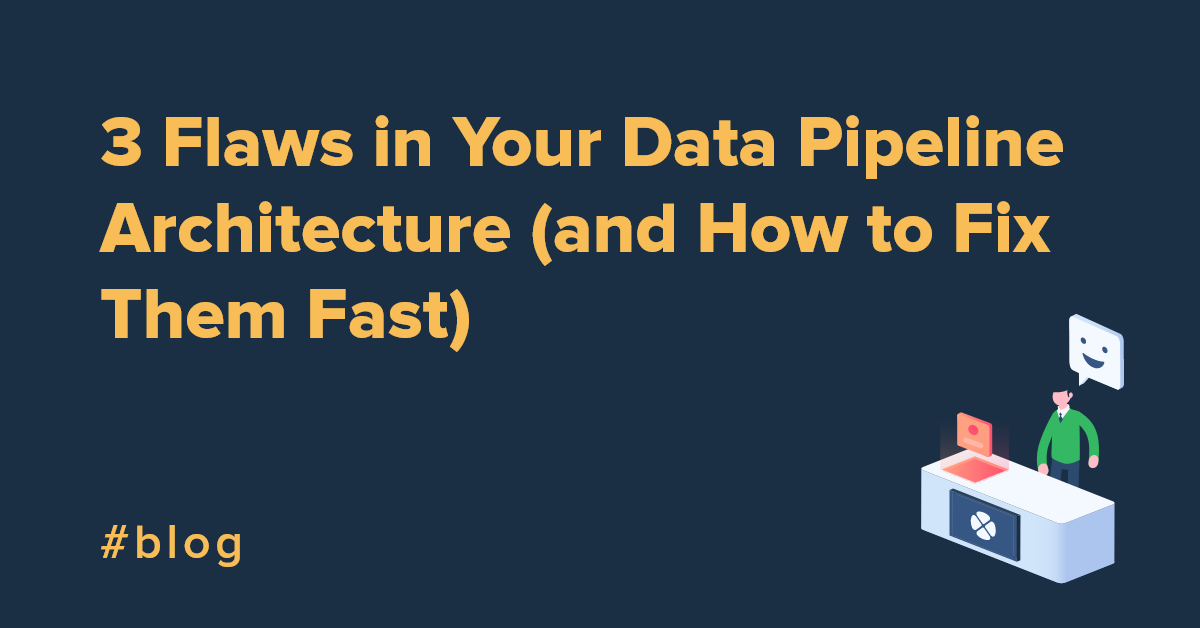An effective data pipeline architecture is the linchpin of any successful modern business. It delivers reliable, consistent, and well-structured datasets to the right places at the right time, so you can power modern data analytics and meet emerging customer needs.
But beware: not all data pipelines are created equal. Any unseen issues in your architecture will not only sabotage your data strategy, they’ll also waste time and money, as you struggle to maintain pipelines that continuously deliver sub-par results. Not good!
To help you achieve a flawless data pipeline architecture, we’re going to cover three of the biggest issues that businesses face. And, because we enjoy passing on our hard-won wisdom, we’re also sharing how to fix them too.
Let’s dive in.
Flaw 1: The results aren’t reproducible and there’s no path to a reliable audit
If you can’t easily reproduce how you got to your data, e.g., in your analysis or audit report, how can you be sure they’re accurate? That’s right – you can’t. You need a way to produce repeatable processes and, therefore, your data architecture must meet these expectations.
Reproducible data analysis allows you to maintain a reliable audit trail. This is essential in sectors like the financial industry where true data transparency can make or break an organization.
Achieving this reproducibility comes from eliminating manual steps and automating routine processes. Instead of manually exporting data from an application, laboring over it in a tool like Excel, you just click ‘Go’ and let your automation software do the legwork.
Not only does this produce more reliable results, you can now scrutinize the process itself, report on the activity in detail, and audit your data more reliably. Yes, there’s higher upfront investment. But this is easily offset by the savings you make over multiple iterations.
One way to help bring transparency and auditability to your data pipelines is to use your data models to directly generate runnable transformations. Check our how we helped one customer do this in our webinar.
Flaw 2: You aren’t cleaning data at the point of entry
Unclean data is the enemy of a good data strategy. That’s because bad data makes it difficult (or sometimes impossible) to get the insights and value you’re looking for.
Unfortunately, it's difficult to clean data further down the line, once it’s been integrated with your entire business. It’s much simpler (and wiser) to clean data at the point of entry.
The fastest way to do this is with an automated solution. Software tools take the pain out of making your data consistent and empower your team to prioritize innovation, rather than spending time massaging data.
Explore: Data ArchitectureIt’s also important to note that eliminating bad data entirely is impossible, which is why it’s best practice to architect for bad data. With this mindset, you’ll be better placed to minimize its negative impact on your business and prevent it from proliferating throughout your systems. What’s more, architecting for bad data will develop a more resilient data strategy and a more proactive data culture.
Flaw 3: You don’t have alerts and monitoring systems in place
Keeping a careful watch over your data pipeline ensures everything is running smoothly. It’s important to catch problems before they balloon into bigger, costlier issues.
If your data pipeline is so broken that it leads to a data breach, the results are especially damaging. It’s no use burying your head in the sand and thinking ‘this won’t happen to me’ – data breaches in the financial sector alone have risen by 480% in the last year.
But manual data checks are both time-consuming and prone to error. A fast and proactive fix is to implement automatic alerts, so your team can gain better visibility into your data pipeline architecture. This helps safeguard against data breaches and enables you to optimize for KPIs such as time to value and data quality.
Monitoring systems is also the key to effective (and pain-free) data validation and reconciliation processes. When you automatically monitor and correct errors, the scale of the data ceases to be an insurmountable challenge. You also get the peace of mind that comes from being able to rollback data to a previous state if your team performs an erroneous operation.
Build your data pipeline architecture the Roman way
Producing repeatable results, cleaning data at the point of entry, and monitoring data health are all essential fixes that will help you improve your data pipeline architecture. Without these things in place, you’ll struggle to recognize emerging trends and deliver the innovative new services that drive your business forward.
While finding and fixing flaws like these and creating an effective data pipeline architecture must become an organizational priority, doing so takes time, patience and a clear idea of what you really need. After all, Rome wasn’t built in a day.
For more on the different options for enterprise data architecture, download your comprehensive guide:
By CloverDX
CloverDX is a comprehensive data integration platform that enables organizations to build robust, engineering-led, ETL pipelines, automate data workflows, and manage enterprise data operations.








